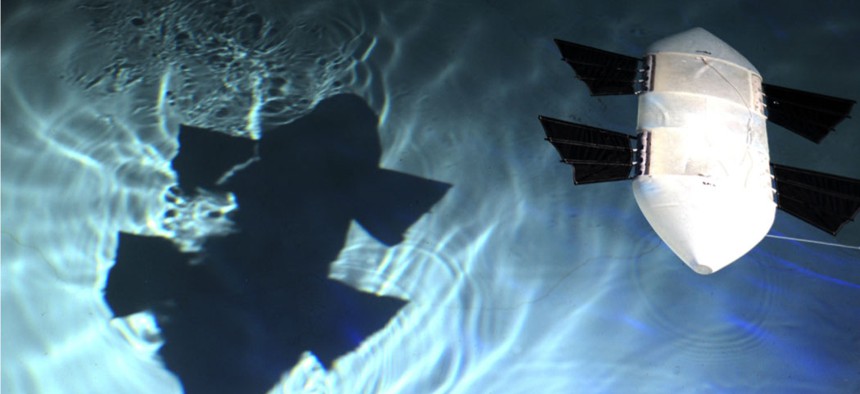DOD plans to invest $600M in unmanned underwater vehicles
Secretary of Defense Ashton Carter told sailors that the Defense Department big plans for UUV over the next five years.
Aerial drones get most of the attention, but the Defense Department also has its eyes on the sea, seeking to invest a great deal in unmanned underwater capabilities.
Secretary of Defense Ashton Carter told sailors aboard the USS Princeton aircraft carrier in San Diego on Feb. 3 that “we’re also investing $600 million over the next five years in variable size and variable payload unmanned undersea vehicles – a new capability you’ll be seeing a lot more of.”
This new capability was described in terms of “distributed lethality,” defined by Carter as “making our ships and aircraft work together in ways that they haven’t before but technology makes possible.”
Undersea unmanned vehicles have been used in the past for a wide variety of mission sets that include mine inspection, hull inspection, gathering data on tides, current and weather conditions for the development of future tasks, and collecting ISR.
The Navy released the “The Navy Unmanned Undersea Vehicle (UUV) Master Plan” in 2004, updating a similar document from 2000 listing 11 mission categories for operations, including:
- Intelligence, surveillance and reconnaissance
- Mine countermeasures
- Anti-submarine warfare
- Inspection / identification
- Oceanography
- Communications / navigation network node
- Payload delivery
- Information operations
- Time critical strike
- Barrier patrol for homeland defense and force protection
- Sea base support .
An updated document was released in 2011, but according to Seapower Magazine it remains classified.
In last year’s budget proposal, the Navy sought to spend $4.8 million in UUV sensors for meteorological purposes. Additionally, funds went toward underwater mine countermeasures, explosive ordnance disposal and UUV incremental capability improvement program retrofit kits.
One of the largest UUV projects for the Navy currently is the Large Displacement Unmanned Undersea Vehicle, which will provide ISR, acoustic surveillance, anti-submarine warfare, mine counter-measures and offensive operations. Testing for the program is still ongoing.
The Director of Unmanned Warfare Systems within the new N99 directorate, Rear Adm. Robert Girrier, told an audience at the Center for Strategic and International Studies that there are incredible opportunities in the undersea domain. “I can think of so many missions that unmanned systems can help out,” he said, noting that there are times when a small unmanned vehicle could do a job that otherwise would require a large, expensive and manned submarine.
Top Navy officials have described a robust plan for undersea operations. “Undersea dominance – that is an inherently Department of Navy domain. And we are just scratching the surface in some of the capabilities to be able to give…forward fleet commanders the emerging capabilities and technologies to build the Eisenhower highway network undersea across the entire sea,” the Chief of Naval Research, Rear Adm. Mathias Winter, said in an August appearance at CSIS, comparing the Navy’s plans for an underwater equivalent of the Interstate Highway system. “Thousands of miles of logistical networks to allow large scale deployment of UUVs, allowing them to communicate, engage, resupply…those technologies are focused around the same technologies that support our directed energy, our unmanned systems and our electric weapons.”
During his remarks in San Diego, Carter said that continued investment in technology is critical to maintaining dominance among other nation’s military capabilities. “The third thing that makes us great is having the greatest technology and the most powerful capabilities of any other military in the world,” he said. “That’s something that we have today and that it’s important that we continue to have 10 years from now, 20 years from now, 30 years from now. So when I and Adm. Richardson, our fantastic chief of naval operations, and all the rest of our leadership and all of you – even as we fight today’s fights, which we have to do – defeating [ISIS], deterring North Korea – we can’t take our eyes off the things of today. We also have to cast our eyes ahead 10, 20, 30 years from now.”
He also, in response to a question about future conflicts, talked about integrating the domains of warfare, including cyberspace and the electromagnetic spectrum. “A second that you’ll see around here is the influence of these new domains that are not surface warfare or subsurface warfare or air warfare; they’re cyber warfare, they’re space warfare, they’re electronic warfare – of course which has been around for a long time – but where there’s tremendous pace of change, [there is] tremendous opportunity. So you’re going to see a fleet that is much more powerful, much more lethal, much more connected,” Carter said.





